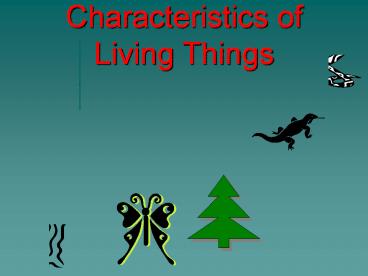Characteristics of Living Things - PowerPoint PPT Presentation
Title:
Characteristics of Living Things
Description:
... of Living Things Made of Cells unicellular vs.. multicellular Red Blood cells Onion skin epidermal cells Human ... reproduction: - asexual ... human beings 2 ... – PowerPoint PPT presentation
Number of Views:256
Avg rating:3.0/5.0
Title: Characteristics of Living Things
1
Characteristics of Living Things
2
Characteristics of Living Things
- Made of Cells
- unicellular vs.. multicellular
Red Blood cells
Onion skin epidermal cells
Human cheek cells
3
Characteristics of Living Things
- 2. Grows and develops
- Increase in cell size and/or number
- Includes development, aging, death
- Differentiation cell specialization for
a certain job
4
Characteristics of Living Things
- 3. Obtains uses Energy
- Metabolism (sum of all chemical reactions)
- Anabolism- simple to complex
- (build up rxns.)
- Catabolism complex to simple
- (break-down rxns.)
- Heterotrophic (other feeding)
- vs. autotrophic (self-feeding)
5
Characteristics of Living Things
- 4. Reproduces
- two kinds of reproduction
- - asexual takes one
- to make more
- - sexual takes two
6
Characteristics of Living Things
- 5. Responds to the Environment
- a. Movement internal or external
- b. Irritability - ability to respond to
- a stimulus
- Examples of stimuli sight, sound, touch,
pressure, temperature, chemicals, color, light,
other? - c. Adaptability
7
Taxonomy
- A. Definition science of naming things
assigning them to groups
8
Taxonomy
- B. Why have a classification system?
- 1. Single, universal name
- 2. Avoid confusion
- 3. Understand how living things are
- related to one another
9
Taxonomy
- What are the FIVE common names of this animal?
10
Taxonomy
- Mountain Lion
- Cougar
- Puma
- (Florida) Panther
- Catamount
Rocky Mountain resident
Florida resident
11
Taxonomy
- Wouldnt it be confusing if we didnt have a
scientific name? - Felis concolor scientific name of the
- mountain lion
- Genus species
12
Taxonomy
- C. Examples of classification systems
- 1. Dewey decimal system library
- 2. Sections of store music store
- 3. Periodic Table of elements - Chemistry
- 4. Others?
13
Taxonomy
- D. Binomial nomenclature
- System of scientific naming
- Developed by Carolus Linnaeus
- (Swedish botanist) in 1750s
- Two part scientific name Genus and species
- Must be underlined or in italics
- In Latin (dead language of scholars)
14
Taxonomy
- E. Example
- Homo sapiens
- (wise man)
- 1. Scientific name
- for human beings
- 2. Homo genus
- (capitalized underlined)
- 3. sapiens species
- (underlined, but NOT
- capitalized)
15
Taxonomy
- F. Definition of species
- 1. breed successfully ? viable,
- fertile offspring
- 2. unique features similar to others of
- same species
- 3. have similar DNA to other species
- members
16
Taxonomy
- G. 7 Taxa of living things ( taxon group)
- Kingdom (kings)
- Phylum (play)
- Class (chess)
- Order (on)
- Family (fine)
- Genus (green)
- Species (silk)
17
Taxonomy
- H. Kingdom is least specific, largest group
- I. Species is most specific,
- contains only one kind of organism
18
Taxonomy
- J. An example
- Kingdom Animalia
- Phylum Chordata
- Class Mammalia
- Order Primates
- Family Hominidae
- Genus Homo
- Species sapiens
19
K. Other Systems of Classification
- Cladograms
20
K. Other Systems of Classification
- 2. Three Domain System
21
Taxonomy
- L. What determines how something
- is classified?
- 1. DNA
- 2. Structure
22
Taxonomy
- 3. Embryology development
23
Taxonomy
- L. ?There are 6 kingdoms of living things
- 1. Archaebacteria
- 2. Eubacteria
- 3. Protista
- 4. Fungi
- 5. Plantae
- 6. Animalia
24
Taxonomy
- M. Definitions
- Prokaryotic does not have a
- nucleus to contain its DNA
- Eukaryotic has a membranebound
- nucleus
25
Taxonomy
- N. Unicellular
- Prokaryotic
- 1. Archaebacteria ancient bacteria
- 2. Eubacteria most bacteria
- Eukaryotic
- 3. Protista single-celled
- O. Multicellular
- 4. Fungi e.g. mushrooms
- 5. Plantae - plants
- 6. Animalia - animals































